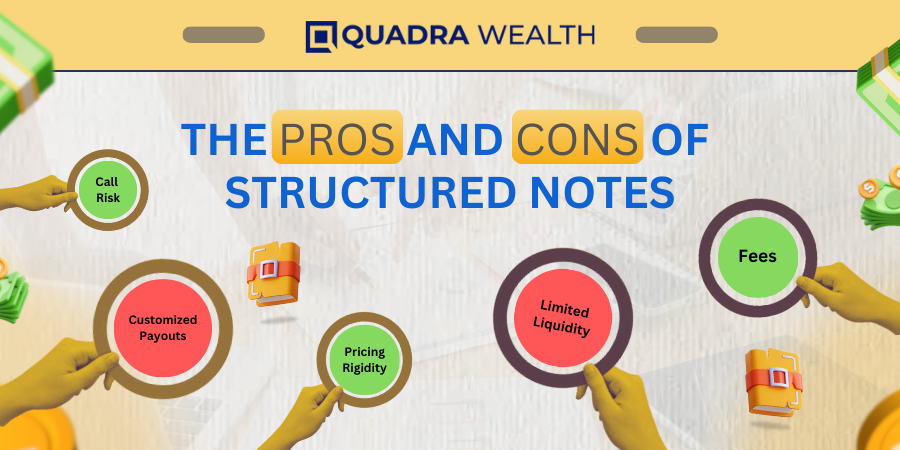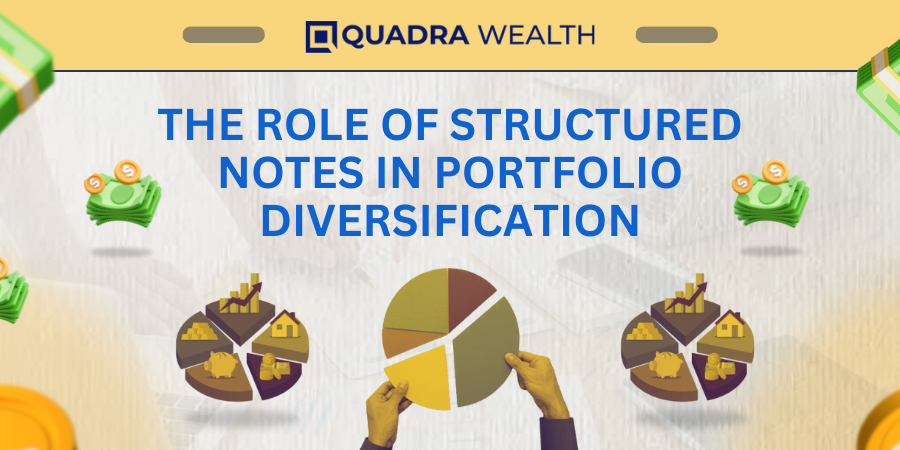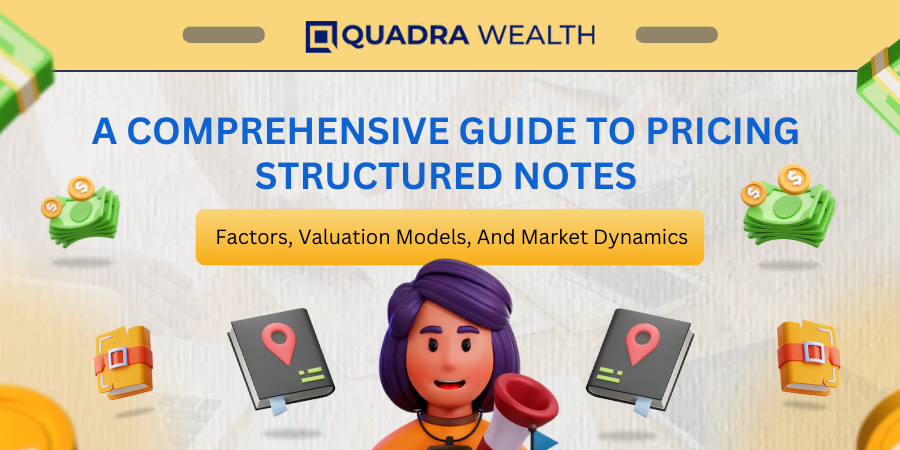Unsure about the intricacies of pricing structured notes? In short, structured notes are complex financial instruments with returns based on various indices or market rates. This guide will demystify every aspect from the influencing factors and valuation models to the dynamics at play in today’s market.
Intrigued? Read on for a deep dive into making sense of your potential investment!

Key Takeaways
- Structured notes have two parts – a bond part and an embedded derivative.
- Factors like market risk, return rates, and time affect the price of structured notes.
- A valuation model helps to set the right price for structured notes.
- The selling side is mostly big banks while the buying side involves normal people.
Understanding Structured Notes
Structured notes are a type of security. Financial institutions make them. They mix two things: a bond part and an embedded derivative part. Here is what they mean: the bond part helps to keep your money safe while the other part, the derivative, adds risk and gives you higher returns if something does well.
You get money from structured notes based on different factors. This can be equity indexes, interest rates, or foreign currencies. There are different types of structured notes like principal protected notes, reverse convertible notes, enhanced participation or leveraged notes, and hybrid notes.
Paying for this kind of note depends on how good an asset or index does over time – that’s why a lot of it can feel risky but also give high rewards. Don’t forget – these are complex deals with high risks for investing money! So use caution when dealing with structured notes! Some common types of structured notes sold to individual investors include principal-protected notes, reverse convertible notes, enhanced participation or leveraged notes, and hybrid notes that combine multiple characteristics.
Key Factors Influencing the Pricing of Structured Notes
In the pricing process of structured notes, various factors play significant roles – these include the level of exposure to market dynamics, anticipated returns on investment, and time taken for potential returns; all impacting the final note value.
Exposure
Exposure means how much downside risk is tied to the underlying assets class. The more exposure, the higher the chance for big gains or losses. If a structured note has equity exposure, it may be linked to stocks.
This can shake up the price of structured notes.
Interest rate exposure plays a part too. It deals with changes in interest rates that affect bonds and other such items in an index. These changes also move the prices of structured notes up and down.
Returns
Structured notes allow you returns based on different things. These include equity indexes, interest rates, and even foreign money rates. You will know the amount of return by looking at a specific asset or index score.
The payoff structure can differ too. It might be leveraged, inverse, or inverse-leveraged. This means your earnings can be higher – but losses can also increase.
Time Savings
Pricing particular structured note correctly can save time. This helps those who issue, trade, and buy these notes. Good pricing models and tech tools make this task faster. They cut down the work done by hand.
So, people can focus more on making smart choices about their money instead of getting lost in numbers.
The Pros and Cons of Structured Notes

Explore the advantages of structured notes such as customized payouts and time savings, along with their downsides including limited liquidity and call risk. Uncover how these factors might impact your investment decisions in our comprehensive guide.
Customized Payouts
Structured notes bring an edge of personal touch. Notes offer payouts that match the needs of investors. You can shape these payouts to fit your plans. This may involve guarding your main money, regular payments, or a stake in other assets gains.
Yet, shaping the payout adds many layers to pricing these notes. The rate change of interest, credit spreads, and market moves are key factors to consider here. These parts decide the price tag of structured notes.
So be sure to understand all angles before you make a choice!
Limited Liquidity
Selling structured notes can be tough. This is because they have limited liquidity. Limited liquidity means there are not many buyers and sellers. When you want to sell your note, the only buyer might be the broker-dealer from the bank that gave you the note in the first place.
The bank’s price might not be fair or good for you. So, selling isn’t always easy or fast with these types of notes.
Pricing Rigidity
Pricing rigidity is common in structured notes. This means their cost doesn’t change much after the date of issue. The price you pay may be more than the fair value of the note from day one.
Also, it might be hard to find what a note’s worth after buying it due to complexity. Selling your notes will likely face hurdles as well, with limited buyers in the secondary market.
Often, only the broker-dealer tied with the firm that issued your note may want it back.
Call Risk
Call risk is a big part of structured notes. This is when the issuer can take back the note before its end date. The buy-back price may be less or more than the face value. If a call event happens, it changes how much money investors make.
They might get less than what they hoped for because the note ends early. But sometimes, investors might get more if the call price beats the face value. This makes it risky and uncertain for those who put their money in structured notes with call options.
Fees
You pay three types of fees when you buy structured notes. The first one is the offering fee. You pay it when you buy the note for the first time. It’s a part of what you invest in structured notes at first.
The second fee gets charged every year and people call it the management fee. It’s a set chunk of your main amount that helped to purchase the note. If your note does well, then there’s another cost named performance fee which takes a small bit out of how much money you gained overall.
Keep in mind, that all these costs can make a dent in the profit made by buying this kind of financial product like structured notes.
Valuation Models for Pricing Structured Note
Valuation models play a big role in figuring out the price of structured notes. The underlying asset that the note is linked to sets its price. For example, if a structured note is tied to gold, and gold prices go up or down, so will the value of the structured note.
The way these assets move also matters. This means how much they go up or down, called volatility, can change the price of your structured note too.
The world around us affects how much a structured note costs as well. Things like what’s happening with money and jobs can make a difference in what you’ll pay for it. Even things we don’t really control like the weather have an effect! If you bought a structured note connected with wheat and bad weather ruins crops, it could cost more than expected due to the lower supply available in marketplaces for trading these kinds of goods.
Prices on things like this – called Exchange Traded Products (ETPs) – are always moving about because there’s such demand for them.
Market Dynamics: Sell Side and Buy Side Stakeholders
Sell-side stakeholders play a big part in the pricing of structured notes. These are often groups like the Office of Investor Education and Advocacy from the SEC. Big banks and other money institutions also fall into this group.
They work with brokers to sell these notes.
On the other hand, buy-side stakeholders include people who want to invest their money wisely. These might be regular folks or even bigger groups making investments for many people (like a retirement fund).
They can choose from different types of structured notes that fit their needs best.
The Role of Structured Notes in Portfolio Diversification

Structured notes play a big part in making a portfolio different. They help spread the money around. This lessens risk. You can fit them to your needs and goals. For example, some people may want more safety.
Others might seek higher returns instead of safety. Structured notes can offer both security and better gains depending on their type. Principal protected notes give back your first amount used even if markets drop down low when it is ending time for sure.
But these safe choices may limit how much you make when times are good with return caps often found in pricing of structured product contracts’ terms of agreement along with knock-in features that could lessen or completely delete protection under certain bad market conditions of failing market prices which come without warning at any given moment threatening institutional investors unknowing of risks from investment in complex securities like structured notes highly promoted by investment banks for increased use due potential higher earnings but increase risk and complexity involved not suitable all investor suitable options must consider carefully before decide important discuss financial adviser agent professional experienced sector business invest wisely safely secure futures better living enjoy life full fullest unlimited unconditional love respect always forever eternal infinity beyond imagination dream aspirations believe achieve success win victory peace prosperity blessing gifts reward fruit labour hard work effort sacrifice perseverance determination commitment dedication discipline focus concentration motivation inspiration creativity innovation ideas solution problem solving skills strategies techniques method approach leadership management communication negotiation persuasion influence followers team member project completion achievement goal target objective mission vision purpose direction journey way path road street highway freeway flyway airway waterway seaway railway gateway doorway passage channel canal tunnel bridge cross junction intersection connection meeting point contact touch feel sense emotion feeling expression speech talk conversation discussion dialogue debate argument analysis evaluation assessment review test research study learning education knowledge wisdom understanding insight foresight hindsight oversight supervision control command authority power freedom liberty independence justice equality fairness balance harmony symphony rhythm melody tune song music dance body mind heart soul spirit character personality trait quality nature feature attribute element aspect benefit advantage gain profit margin split share stake claim title deed property rights legal copyright trademark patent license permit certificate approval authorization validation verification confirmation affirmation reinforcement reassurance confidence trust faith belief hope patience humbleness humility modesty simplicity sincerity honesty truth reliability dependability responsibility accountability obligation duty charge task job employment career profession trade industry company corporation organization institution association union club group party community society humanity civilization world planet earth cosmos universe space stars
Conclusion
Structured notes may be a valuable part of your investment. They help add variety to your portfolio. These notes come with risks, but knowing how they’re priced helps you make smart choices.
Stay aware and keep learning about them if you plan to invest.

FAQs






